Ecological and Health Risk Assessments of an Abandoned Gold Mine (Remance, Panama): Complex Scenarios Need a Combination of Indices
Abstract
:1. Introduction
2. Materials and Methods
2.1. Study Area
2.2. Sampling
- -
- 43 soil samples, including 19 samples collected in the mining area around the tailings and excavations of the mine’s veins and tunnels, and 24 samples collected within the perimeter of the mine and its surroundings;
- -
- 39 sediment samples, including 19 fluvial active channel stream sediments and 20 fluvial terrace sediment samples taken from the banks of water bodies;
- -
- 7 rock samples collected from outcrops to acquire data about the general lithology in the area.
2.3. Sample Preparation and Analysis
2.4. Methods
2.4.1. Pollution Index and Pollution Load Index
2.4.2. Toxicity Response Coefficient and the Potential Ecological Risk Index
2.4.3. Human Health Risk Assessment
Non-Carcinogenic Risk
Carcinogenic Risk
2.4.4. Statistical Analyses
3. Results
3.1. Total Contents
3.2. Spatial Variability
3.3. Mineralogical Analysis
3.4. DHA and Correlations with Edaphic Parameters and PTEs
3.5. Multi-Elemental Analysis
3.6. Pollution Index (PI) and Pollution Load Index (PLI)
3.7. Toxicity Response Coefficient (Er) and Potential Ecological Risk Index (RI)
3.8. Human Health Risk Assessment
3.8.1. Non-carcinogenic Risk (HI)
3.8.2. Carcinogenic Risk (CR)
4. Discussion
5. Conclusions
Supplementary Materials
Author Contributions
Funding
Institutional Review Board Statement
Informed Consent Statement
Data Availability Statement
Acknowledgments
Conflicts of Interest
References
- Kamunda, C.; Mathuthu, M.; Madhuku, M. Health Risk Assessment of Heavy Metals in Soils from Witwatersrand Gold Mining Basin, South Africa. Int. J. Environ. Res. Public Health 2016, 13, 663. [Google Scholar] [CrossRef] [PubMed]
- Ramappa, H.; Muniswamy, D. Spatial Distribution of Heavy Metals around the Gold Mine Ore Tailings of Hatti, Karnataka State, India. Landsc. Environ. 2018, 11, 35–44. [Google Scholar] [CrossRef]
- Kaninga, B.; Chishala, B.; Maseka, K.; Sakala, G.; Lark, M.; Tye, A.; Watts, M. Review: Mine tailings in an African tropical environment-mechanisms for the bioavailability of heavy metals in soils. Environ. Geochem. Health 2020, 42, 1069–1094. [Google Scholar] [CrossRef]
- Elmayel, I.; Esbrí, J.; García-Ordiales, E.; Elouaer, Z.; García-Noguero, E.; Bouzid, J.; Campos, J.; Higueras, P. Biogeochemical assessment of the impact of Zn mining activity in the area of the Jebal Trozza mine, Central Tunisia. Environ. Geochem. Health 2020, 42, 3529–3542. [Google Scholar] [CrossRef]
- Pan, Y.; Peng, H.; Xie, S.; Zeng, M.; Huang, C. Eight Elements in Soils from a Typical Light Industrial City, China: Spatial Distribution, Ecological Assessment, and the Source Apportionment. Int. J. Environ. Res. Public Health 2019, 16, 2591. [Google Scholar] [CrossRef] [PubMed] [Green Version]
- Sadras, V.; Alston, J.; Aphalo, P.; Connor, D.; Denison, R.F.; Fischer, T.; Gray, R.; Hayman, P.; Kirkegaard, J.; Kirchmann, H.; et al. Chapter Four-Making science more effective for agriculture. Adv. Agron. 2020, 163, 153–177. [Google Scholar] [CrossRef]
- Silveira, M.; Kohmann, M. Chapter 3—Maintaining soil fertility and health for sustainable pastures. In Management Strategies for Sustainable Cattle Production in Southern Pastures; Academic Press: Cambridge, MA, USA, 2020; pp. 35–58. [Google Scholar] [CrossRef]
- Kumar, S.; Chaudhuri, S.; Maiti, S. Soil dehydrogenase enzyme activity in natural and mine soil—A review. Middle-East J. Sci. Res. 2013, 13, 898–906. [Google Scholar] [CrossRef]
- Wolinska, A.; Stepniewska, Z. Dehydrogenase Activity in the Soil Environment. In Dehydrogenase; Intechopen: London, UK, 2012; Chapter 8; pp. 183–210. [Google Scholar] [CrossRef] [Green Version]
- Zhang, N.; He, X.; Gao, Y.; Li, Y.; Wang, H.; Ma, D.; Zhang, R.; Yang, S. Pedogenic Carbonate and Soil Dehydrogenase Activity in Response to Soil Organic Matter in Artemisia ordosica Community. Pedosphere 2010, 20, 229–235. [Google Scholar] [CrossRef]
- Gallego, S.; Esbrí, J.M.; Campos, J.A.; Peco, J.D.; Martin-Laurent, F.; Higueras, P. Microbial diversity and activity assessment in a 100-year-old lead mine. J. Hazard. Mater. 2021, 410, 124618. [Google Scholar] [CrossRef]
- Kierczak, J.; Neel, C.; Aleksander-Kwaterczak, U.; Helios-Rybicka, E.; Bril, H.; Puziewicz, J. Solid speciation and mobility of potentially toxic elements from natural and contaminated soils: A combined approach. Chemosphere 2008, 73, 776–784. [Google Scholar] [CrossRef]
- Rodríguez-Hernández, A.; Lázaro, I.; Razo, I.; Briones-Gallardo, R. Geochemical and mineralogical characterization of stream sediments impacted by mine wastes containing arsenic, cadmium and lead in North-Central Mexico. J. Geochem. Explor. 2021, 221, 106707. [Google Scholar] [CrossRef]
- Bravo, S.; Amorós, J.; Pérez de los Reyes, C.; García, F.; Moreno, M.; Sánchez-Ormeño, M.; Higueras, P. Influence of the soil pH in the uptake and bioaccumulation of heavy metals (Fe, Zn, Cu, Pb and Mn) and other elements (Ca, K, Al, Sr and Ba) in vine leaves, Castilla-La Mancha (Spain). J. Geochem. Explor. 2015, 174, 79–83. [Google Scholar] [CrossRef]
- Sun, Z.; Chen, J. Risk Assessment of Potentially Toxic Elements (PTEs) Pollution at a Rural Industrial Wasteland in an Abandoned Metallurgy Factory in North China. Int. J. Environ. Res. Public Health 2018, 15, 85. [Google Scholar] [CrossRef] [PubMed] [Green Version]
- Agency for Toxic Substances and Disease Registry (ATSDR). The ATSDR 2019 Substance Priority List. Available online: https://www.atsdr.cdc.gov/spl/index.html (accessed on 18 May 2021).
- Bini, C.; Wahsha, M. Potentially Harmful Elements and Human Health. In Book PHEs, Environment and Human Health: Potentially Harmful Elements in the Environment and the Impact on Human Health; Bini, C., Bech, J., Eds.; Springer Nature Switzerland AG: Cham, Switzerland, 2014; Chapter 11. [Google Scholar] [CrossRef] [Green Version]
- Agency for Toxic Substances and Disease Registry (ATSDR). Toxicological Profile for Cyanide; U.S. Department of Health and Human Services, Public Health Service, Agency for Toxic Substances and Disease Registry: Atlanta, GA, USA, 2006. Available online: https://www.atsdr.cdc.gov/toxprofiles/tp8.pdf (accessed on 23 October 2020).
- Gruszecka-Kosowska, A.; Baran, A.; Wdowin, M.; Mazur-Kajta, K.; Czech, T. The content of the potentially harmful elements in the arable soils of southern Poland, with the assessment of ecological and health risks: A case study. Environ. Geochem. Health 2020, 42, 419–442. [Google Scholar] [CrossRef] [Green Version]
- Dirección de Hidrometeorología de ETESA. Mapa de Clasificación Climática (según Köppen) de Panamá, año 2007. Available online: http://www.hidromet.com.pa/mapas.php (accessed on 23 May 2020).
- Instituto Geográfico Nacional Tommy Guardia (IGNTG). Atlas Nacional de la República de Panama; Instituto Geográfico Nacional “Tommy Guardia”: Panama City, Panama, 1988. [Google Scholar]
- Gómez, A. Contaminación Ambiental en Áreas Asociadas con Minas Antiguas de oro. Determinación de Cianuro en Agua y de Trazas Metálicas en Sedimentos, en las Quebradas Aledañas a las Minas Remance y Santa Rosa. Master’s Thesis, Universidad Tecnológica de Panamá, Panama City, Panama, 2008; 500p. [Google Scholar]
- Nelson, C.; Ganoza, J. Mineralización de oro en la franja aurífera de Veraguas, Panamá. Rev. Geol. Am. Cent. 1999, 2, 87–100. [Google Scholar] [CrossRef] [Green Version]
- Hughes, W. Minería ¿Desarrollo o Destrucción? Pastoral Social-Cáritas Panamá Editores: Panama City, Panama, 1998; 221p. [Google Scholar]
- Radio Temblor. Continúan las Protestas Contra la Minería y Corrupción en Panamá (Reactivan Mina de Remance, en Veraguas). Available online: https://www.radiotemblor.org/continuan-las-protestas-contra-la-mineria-y-corrupcion-en-panama-reactivan-mina-remance-en-veraguas/ (accessed on 21 June 2021).
- González-Valoys, A.; Arrocha, J.; Monteza-Destro, T.; Vargas-Lombardo, M.; Esbrí, J.; García-Ordiales, E.; Jiménez-Ballesta, R.; García-Navarro, F.; Higueras, P. Environmental challenges related with cyanidation in Central American gold mining, Remance mine (Panama). J. Environ. Manag. 2021. under review. [Google Scholar]
- Sánchez-Donoso, R.; Martín Duque, J.F.; Crespo Feo, E.; Higueras, P. Tailing’s geomorphology of the San Quintín mining site (Spain): Landform catalogue, aeolian erosion and environmental implications. Environ. Earth Sci. 2019, 78, 166. [Google Scholar] [CrossRef]
- Ministerio de Ambiente Panamá. Mapa de Cobertura y Uso de la Tierra, en la República de Panamá del Año; Ministerio de Ambiente: Panama City, Panama, 2012; p. 1. Available online: https://www.unredd.net/index.php?view=download&alias=14898-mapa-de-cobertura-boscosa-y-uso-de-la-tierrainforme-final&category_slug=sistema-satelital-monitoreo&option=com_docman&Itemid=134 (accessed on 10 March 2019).
- American Society Testing of Materials (ASTM). Annual Book of ASTM Standars; International Standard World Wide; American Society Testing of Materials: West Conshohocken, PA, USA, 2004; Volume 04.08–04.09. [Google Scholar]
- Weaver, R.; Syers, J.; Jackson, M. Análisis Químico de Suelos; Omega: Madrid, Spain, 1991; 267p, ISBN 978-8428201438. [Google Scholar]
- Porta, J. Técnicas y Experimentos en Edafología; Colegio Oficial de Ingenieros Agrónomos de Cataluña: Barcelona, Spain, 1986; 282p. [Google Scholar]
- Molina, J.A.; Oyarzun, R.; Esbrí, J.M.; Higueras, P. Mercury accumulation in soils and plants in the Almadén mining district, Spain: One of the most contaminated sites on earth. Environ. Geochem. Health 2006, 28, 487–498. [Google Scholar] [CrossRef] [PubMed]
- Internacional Organization for Standardization (ISO). Water Quality—Determination of Total Cyanide and Free Cyanide Using Flow Analysis (FIA and CFA)—Part 2: Method Using Continuous Flow Analysis (CFA) (ISO 14403-2); International Standard ISO 14403-2:2012(E); ISO: Geneva, Switzerland, 2012; Available online: https://cdn.standards.iteh.ai/samples/52208/a9978a96d31945d194f5881b2dd8ddd2/ISO-14403-2-2012.pdf (accessed on 10 June 2021).
- Casida, L.; Klein, D.; Santoro, T. Soil Dehydrogenase Activity. Soil Sci. 1964, 98, 371–376. [Google Scholar] [CrossRef]
- Tan, X.; Liu, Y.; Yan, K.; Wang, Z.; Lu, G.; He, Y.; He, W. Differences in the response of soil dehydrogenase activity to Cd contamination are determined by the different substrates used for its determination. Chemosphere 2017, 169, 324–332. [Google Scholar] [CrossRef] [PubMed]
- Campos, J.A.; Esbrí, J.M.; Madrid, M.M.; Naharro, R.; Peco, J.; García-Noguero, E.M.; Higueras, P. Does mercury presence in soils promote their microbial activity? the Almadenejos case (Almadén mercury mining district, Spain). Chemosphere 2018, 201, 799–806. [Google Scholar] [CrossRef]
- Rietveld, H. A profile refinement method for nuclear and magnetic structures. J. Appl. Cryst. 1969, 2, 65–71. [Google Scholar] [CrossRef]
- Rodríguez-Carvajal, J. Recent advances in magnetic structure determination by neutron powder diffraction. Phys. B 1993, 55, 192–202. [Google Scholar] [CrossRef]
- Young, R.A. The Rietveld Method; International Union of Crystallography, Oxford University Press: Oxford, UK, 1995. [Google Scholar]
- García-Lorenzo, M.; Crespo-Feo, E.; Esbrí, J.; Higueras, P.; Grau, P.; Crespo, I.; Sánchez-Donoso, R. Assessment of potentially toxic elements in technosols by tailings derived from Pb-Zn-Ag mining activities at San Quintín (Ciudad Real, Spain): Some insights into the importance of integral studies to evaluate metal contamination pollution hazards. Minerals 2019, 9, 346. [Google Scholar] [CrossRef] [Green Version]
- Tomlinson, D.; Wilson, J.; Harris, C.; Jeffrey, D. Problems in the assessment of heavy-metal levels in estuaries and the formation of a pollution index. Helgoländer Meeresunters 1980, 33, 566–575. [Google Scholar] [CrossRef] [Green Version]
- Hakanson, L. An ecological risk index for aquatic pollution control. A sedimentological approach. Water Res. 1980, 14, 975–1001. [Google Scholar] [CrossRef]
- Wang, N.; Wang, A.; Kong, L.; He, M. Calculation and application of Sb toxicity coefficient for potential ecological risk assessment. Sci. Total Environ. 2018, 610–611, 167–174. [Google Scholar] [CrossRef]
- U.S. Environmental Protection Agency. Risk Assessment Guidance for Superfund, Vol. 3: Part A, Process for Conducting Probabilistic Risk Assessment; Office of Emergency and Remedial Response, USEPA: Washington, DC, USA, 2001.
- U.S. Environmental Protection Agency. Risk Assessment Guidance for Superfund, Vol. 1: Human Health Evaluation Manual (Part E, Supplemental Guidance for Dermal Risk Assessment), Final; Office of Superfund Remediation and Technology Innovation, USEPA: Washington, DC, USA, 2004.
- U.S. Environmental Protection Agency. Risk Assessment Guidance for Superfund Volume I: Human Health Evaluation Manual (Part F, Supplemental Guidance for Inhalation Risk Assessment) Final; Office of Superfund Remediation and Technology Innovation, OSWER Directive 9285,7-82, EPA-540-R-070-002; US Environmental Protection Agency: Washington, DC, USA, 2009.
- Department of Environmental Affairs. The Framework for the Management of Contaminated Land, South Africa, Year 2010. Available online: http://sawic.environment.gov.za/documents/562.pdf (accessed on 4 May 2020).
- U.S. Environmental Protection Agency. Risk Assessment Guidance for Superfund, Vol. 1: Human Health Evaluation Manual, Part A, Interim Final; Office of Emergency and Remedial Response, USEPA: Washington, DC, USA, 1989.
- Wcisło, E.; Bronder, J.; Bubak, A.; Rodriguez-Valdés, E.; Gallego, J.L.R. Human health risk assessment in restoring safe and productive use of abandoned contaminated sites. Environ. Int. 2016, 94, 436–448. [Google Scholar] [CrossRef]
- U.S. Environmental Protection Agency. Regional Screening Level (RSL) Summary Table (TR = 10−6, HQ = 1), April 2019; US Environmental Protection Agency: Washington, DC, USA, 2019. Available online: https://semspub.epa.gov/src/document/HQ/199432 (accessed on 12 April 2021).
- Gaceta Oficial Digital de Panamá. Decreto Ejecutivo N° 2 “Por el cual se establece la Norma Ambiental de Calidad de Suelos para diversos usos”; Ministerio de Economía y Finanzas: Panama City, Panama, 2009; Issue 26230, pp. 1–26. Available online: http://www.cnpml.org.pa/images/nosotros/suelo/decrejecut2.pdf (accessed on 10 March 2019).
- Ministerio de Salud. Reglamento Sobre Valores Guía en Suelos Para Descontaminación 602 de Sitios Afectados por Emergencias Ambientales y Derrames; N° 37757-S; Ministerio de Salud: San José, Costa Rica, 2010; pp. 15, 603. Available online: http://www.mag.go.cr/legislacion/2013/de-37757.pdf (accessed on 10 April 2020).
- Palansooriyaa, K.; Shaheenb, S.; Chene, S.; Tsange, D.; Hashimotof, Y.; Houg, D.; Bolanh, N.; Rinklebeb, J.; Oka, Y. Soil amendments for immobilization of potentially toxic elements in contaminated soils: A critical review. Environ. Int. 2020, 134, 105046. [Google Scholar] [CrossRef]
- Sabadini-Santos, E.; Castilhos, Z.C.; Bidone, E.D. Microbial Activities Response to Contamination in Soil and Sediments Rich in As Surrounding an Industrial Gold Mine. Water Air Soil Pollut. 2020, 231, 366. [Google Scholar] [CrossRef]
- Meier, S.; Curaqueo, G.; Khan, N.; Bolan, N.; Rilling, J.; Vidal, C.; Borie, F. Effects of biochar on copper immobilization and soil microbial communities in a metal-contaminated soil. J. Soils Sediments 2017, 17, 1237–1250. [Google Scholar] [CrossRef]
- Mukhopadhyay, S.; Maiti, S.K. Dehydrogenase activity in natural and mine soil—A review. Indian J. Environ. Prot. 2010, 30, 921–933. [Google Scholar]
- Iribarren, I.; Chacón, E.; De Miguel, E. A Bayesian approach to probabilistic risk assessment in municipal playgrounds. Arch. Environ. Contam. Toxicol. 2009, 56, 165–172. [Google Scholar] [CrossRef]
- Harris, M.; Stinson, J.; Landis, W. A Bayesian approach to integrated ecological and human health risk assessment for the South river, Virginia mercury-contaminated site. Risk Anal. 2017, 37, 1341–1357. [Google Scholar] [CrossRef]
- Jiménez-Oyola, S.; García-Martínez, M.; Ortega, M.F.; Bolonio, D.; Rodríguez, C.; Esbrí, J.M.; Higueras, P. Multi-pathway human exposure risk assessment using Bayesian modeling at the historically largest mercury mining district. Ecotoxicol. Environ. Saf. 2020, 201. [Google Scholar] [CrossRef]
- Hossen, M.A.; Chowdhury, A.I.H.; Mullick, M.R.A.; Hoque, A. Heavy metal pollution status and health risk assessment vicinity to Barapukuria coal mine area of Bangladesh. Environ. Nanotechnol. Monit. Manag. 2021, 16, 100469. [Google Scholar] [CrossRef]
- Chen, X.; Li, F.; Zhang, J.; Liu, S.; Ou, C.; Yan, J.; Sun, T. Status, fuzzy integrated risk assessment, and hierarchical risk management of soil heavy metals across China: A systematic review. Sci. Total Environ. 2021, 785, 147180. [Google Scholar] [CrossRef]
- Liang, J.; Feng, C.; Zeng, G.; Gao, X.; Zhong, M.; Li, X.; Li, X.; He, X.; Fang, Y. Spatial distribution and source identification of heavy metals in surface soils in a typical coal mine city, Lianyuan, China. Environ. Pollut. 2017, 225, 681–690. [Google Scholar] [CrossRef]
- Hosseini, M.; Rezazadeh, M.; Salimi, A.; Ghorbanli, M. Distribution of heavy metals and arsenic in soils and indigenous plants near an iron ore mine in northwest Iran. Acta Ecol. Sin. 2018, 38, 363–367. [Google Scholar] [CrossRef]
- Sun, Z.; Xie, X.; Wang, P.; Hu, Y.; Cheng, H. Heavy metal pollution caused by small-scale metal ore mining activities: A case study from a polymetallic mine in South China. Sci. Total Environ. 2018, 639, 217–227. [Google Scholar] [CrossRef] [PubMed]
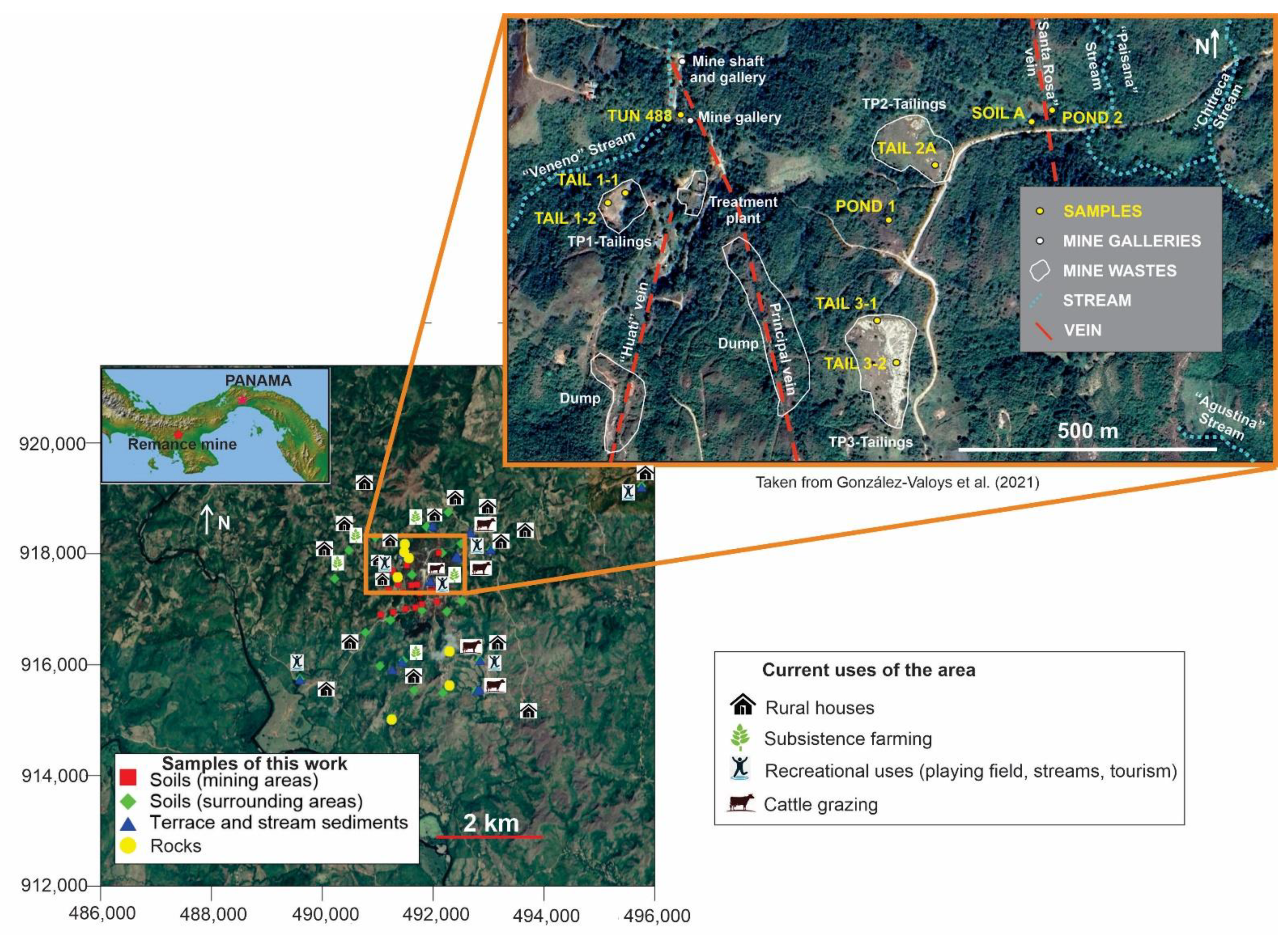

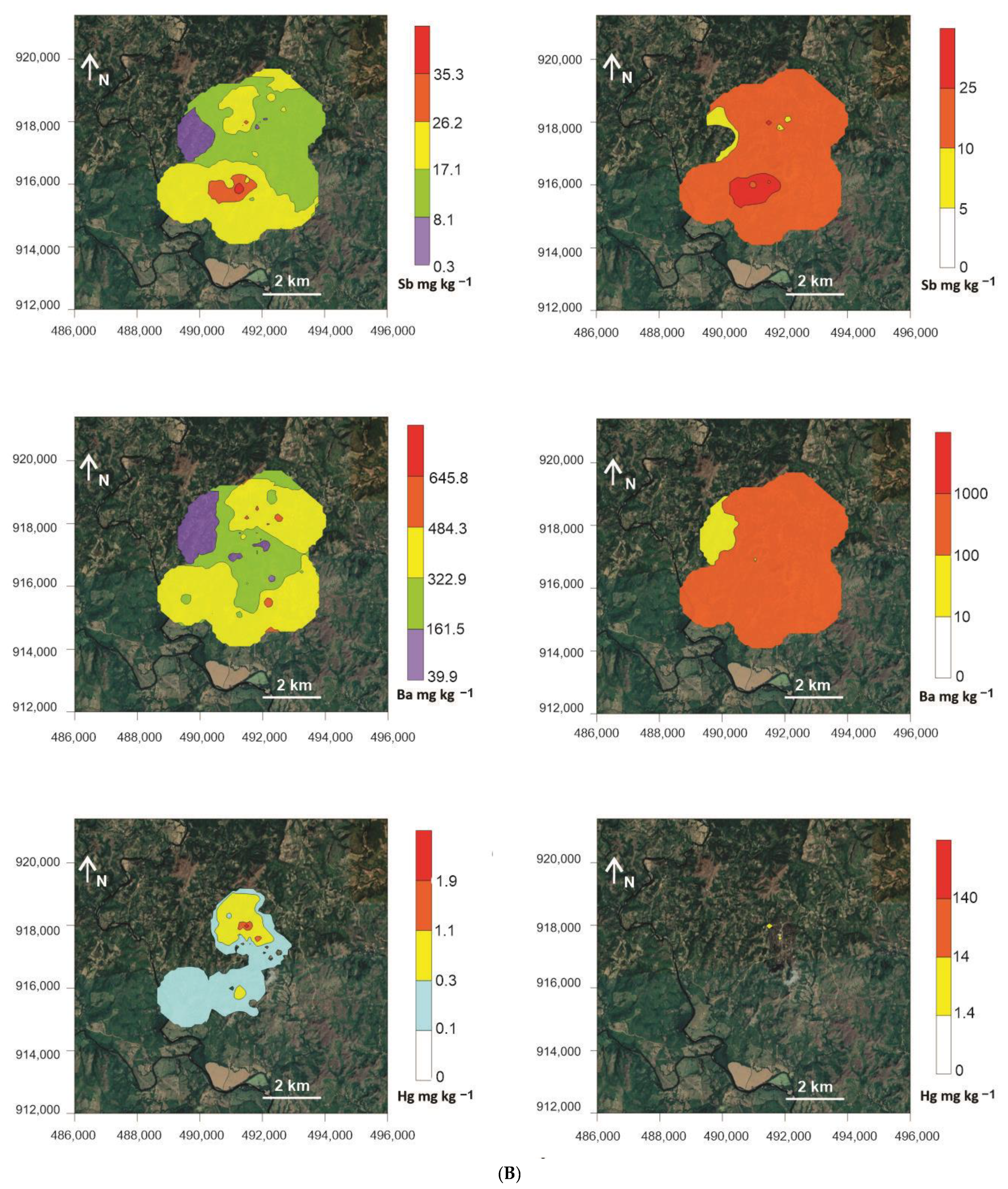
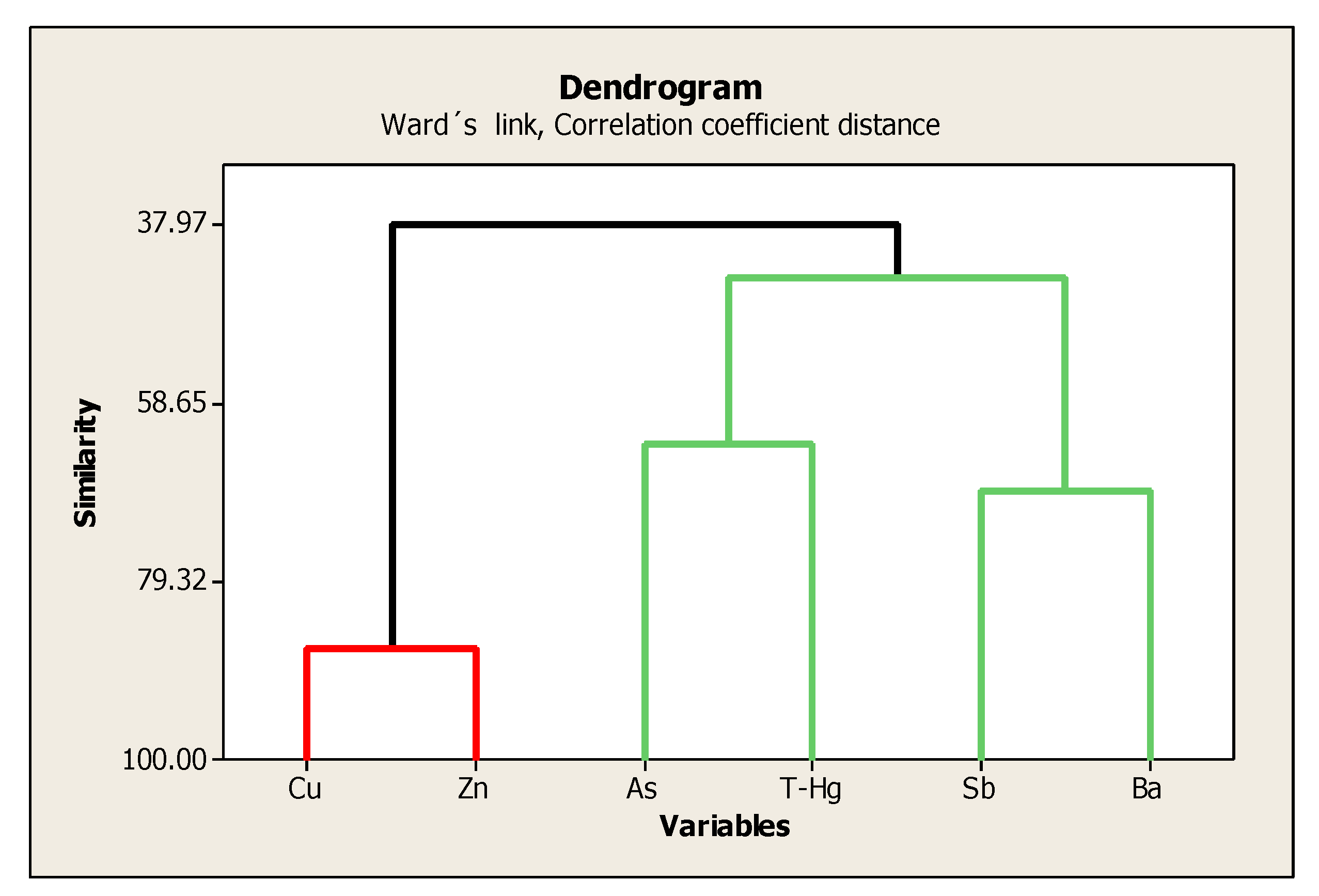
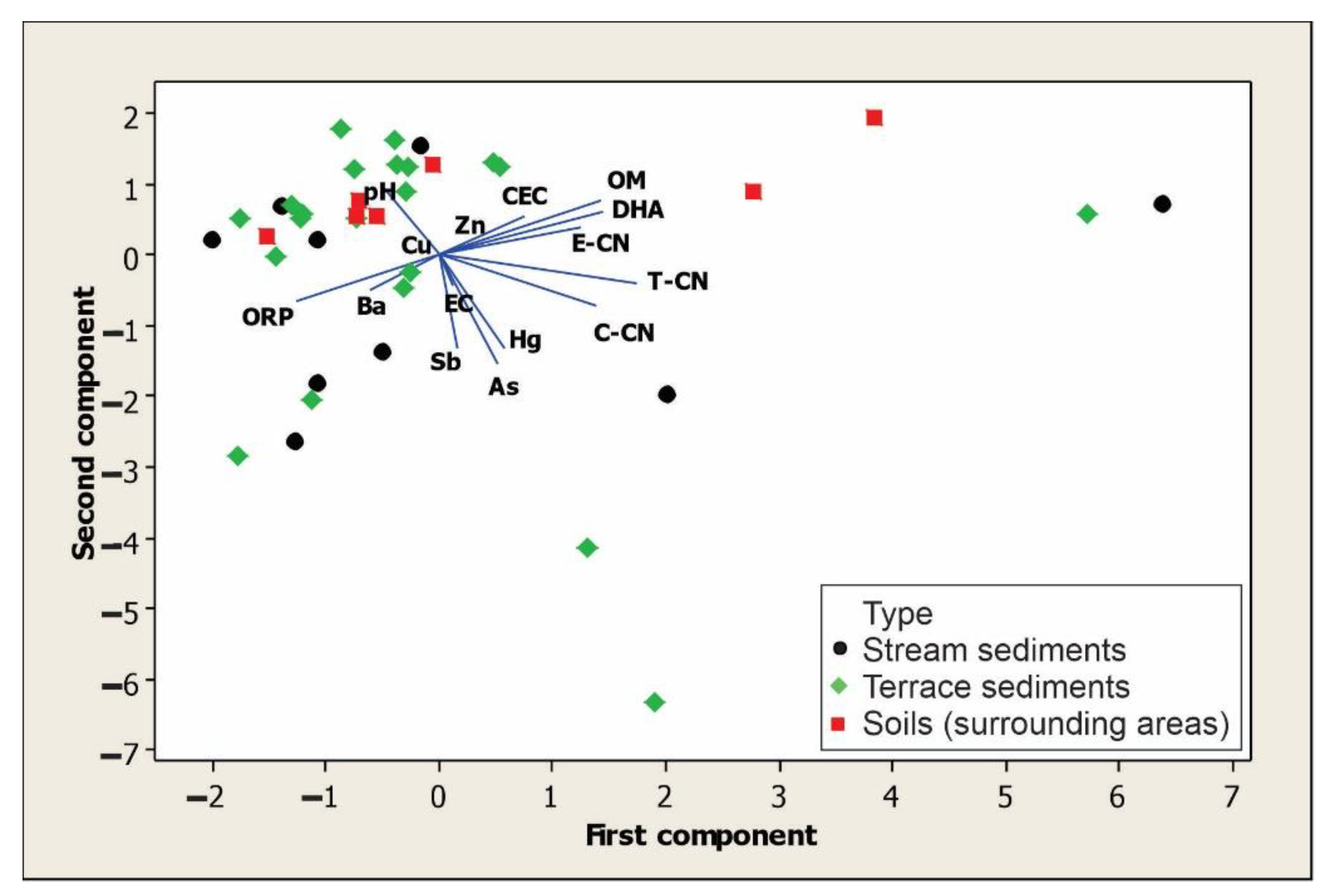
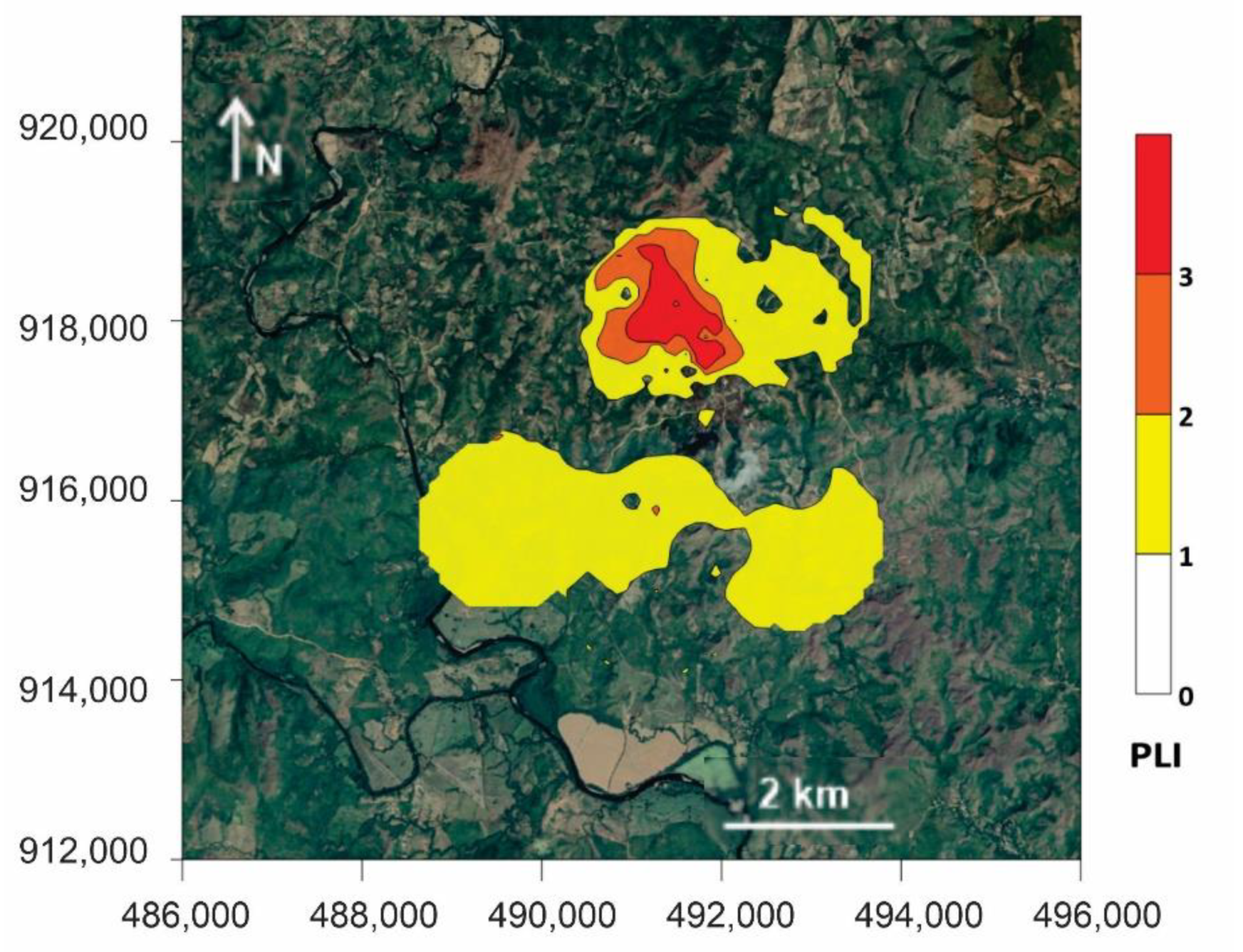


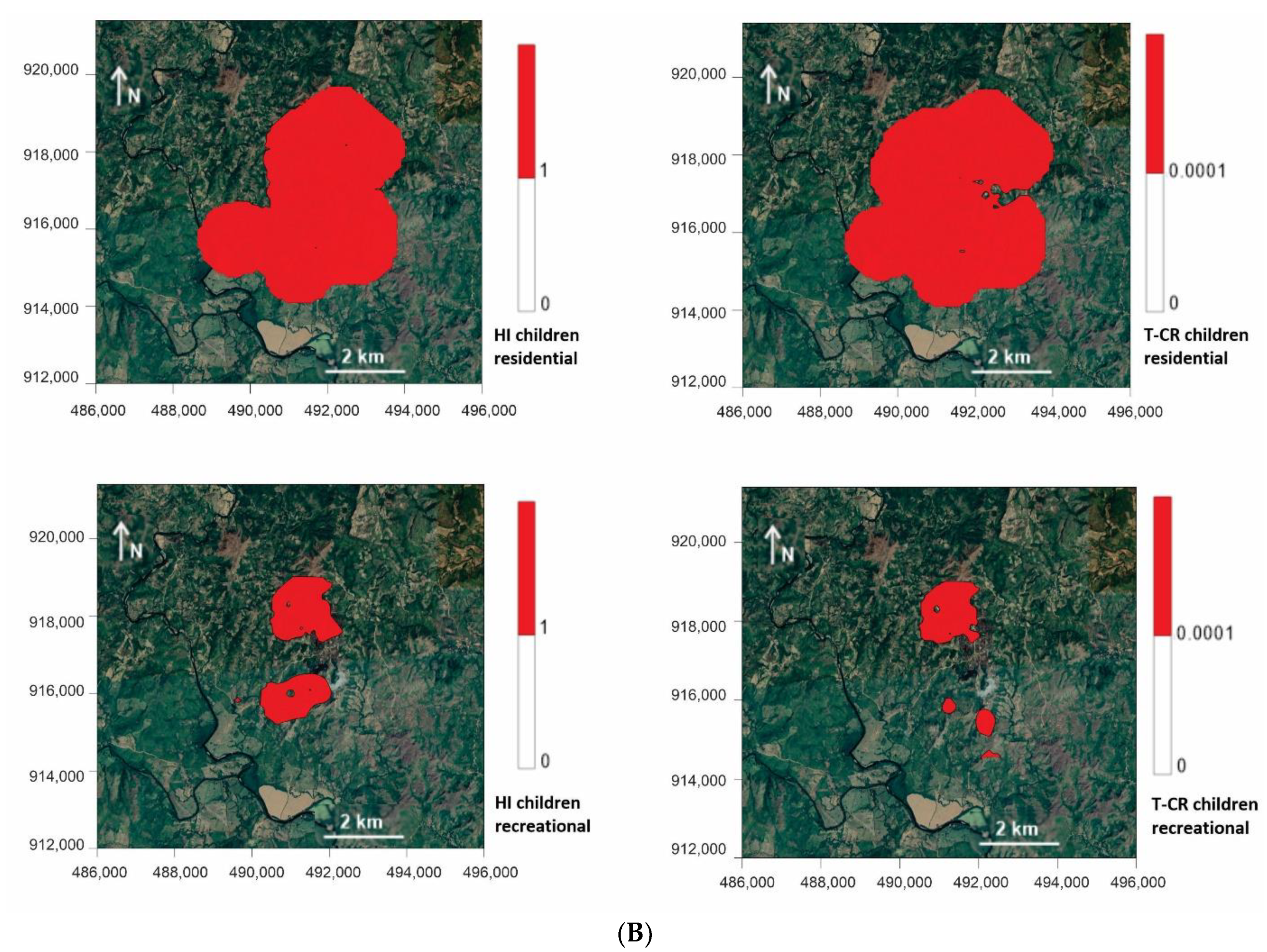
| Index | No Polluted | Slightly Polluted | Moderately Polluted | Considerably Polluted | Seriously Polluted | Extremely Polluted |
|---|---|---|---|---|---|---|
| PLI/PI | <1 | 1 < PLI < 2 | 2 < PLI < 3 | PLI > 3 | - | - |
| Er | <10 | <40 | 40 < Er < 80 | 80 < Er < 160 | 160 < Er < 320 | Er > 320 |
| RI | <50 | <150 | 150 < RI < 300 | 300 < RI < 600 | 600 < RI < 1200 | RI > 1200 |
| Parameter | Unit | Residential | Recreational | Agricultural | ||
|---|---|---|---|---|---|---|
| Adult | Child | Adult | Child | Adult | ||
| Exposure frequency (EF) | day year−1 | 365 | 365 | 96 | 96 | 250 |
| Exposure duration (ED) | year | 30 a | 6 | 30 a | 6 | 40 |
| Averaging time (AT) | year day | |||||
| Non carcinogenic | ED × EF | ED × EF | ED × EF | ED × EF | ED × EF | |
| Carcinogenic | 70 × EF | 70 × EF | 70 × EF | 70 × EF | 70 × EF | |
| Ingestion | ||||||
| Ingestion rate in soil (IRing) | mg kg−1 | 100 | 200 | 100 | 200 | 100 |
| Fraction ingested (FI) | unitless | 1 | 1 | 1 | 1 | 1 |
| Dermal contact | ||||||
| Adherence factor (AF) | mg (cm2 event)−1 | 0.07 | 0.2 | 0.07 | 0.2 | 0.07 |
| Event frequency (EV) | events day−1 | 1 | 1 | 1 | 1 | 1 |
| Skin surface area contact (SA) | cm2 | 6032 | 2373 | 6032 | 2373 | 6032 b |
| Inhalation | ||||||
| Inhalation rate (IRair)a | m3 day−1 | 20 | 10 | 20 | 10 | 20 |
| Particulate emission factor (PEF) | m3 kg−1 | 1.36 × 109 | 1.36 × 109 | 1.36 × 109 | 1.36 × 109 | 1.36 × 109 |
| Element | (Unitless) | RfD (mg kg−1 day−1) | SF (mg kg−1 day−1)−1 | ||||||
|---|---|---|---|---|---|---|---|---|---|
| RBA a | ABSd a | GIABS b | RfDo b | RfDd c | RfDinh d | Sfo e | SFd c | Sfinh d | |
| Cu | 1 | 0.01 | 1 | 4.0 × 10−2 | 4.0 × 10−2 | - | 1.7 | 1.7 | - |
| Zn | 1 | 0.01 | 1 | 3.0 × 10−1 | 3.0 × 10−1 | - | - | - | - |
| As | 0.6 | 0.03 | 1 | 3.0 × 10−4 | 3.0 × 10−4 | 3.0 × 10−4 | 1.5 | 1.5 | 15 |
| Sb | 1 | 0.01 | 0.15 | 4.0 × 10−4 | 2.7 × 10−3 | - | - | - | - |
| Ba | 1 | 0.01 | 0.07 | 2.0 × 10−1 | 2.9 × 100 | - | - | - | - |
| Hg | 1 | 0.01 | 0.07 | 3.0 × 10−4 | 4.3 × 10−3 | 8.6 × 10−5 | - | - | - |
| Sample Type | N | pH | EC | OM (%) | Cu | Zn | As | Sb | Ba | Hg |
|---|---|---|---|---|---|---|---|---|---|---|
| (dS m−1) | ||||||||||
| Soils (mining area) a | 19 | 5.9 ± 0.5 | 0.03 ± 0.03 | 8.2 ± 3.8 | 61.3 ± 51.8 | 46.9 ± 23.9 | 56.4 ± 54.4 | 13.7 ± 2.6 | 200.6 ± 123.5 | 0.11 ± 0.16 |
| Soils (surrounding areas) a | 24 | 5.2 ± 0.4 | 0.05 ± 0.04 | 5.1 ± 2.0 | 93.5 ± 85.6 | 62.8 ± 35.9 | 35.5 ± 44.2 | 16.4 ± 5.4 | 349.7 ± 198.0 | 0.06 ± 0.06 |
| Terrace sediments a | 20 | 5.3 ± 1.0 | 0.14 ± 0.22 | 4.3 ± 2.2 | 65.2 ± 32.7 | 55.3 ± 18.8 | 152.7 ± 210.3 | 19.8 ± 8.9 | 355.7 ± 115.0 | 0.62 ± 1.48 |
| Stream sediments a | 19 | 5.8 ± 0.5 | 0.07 ± 0.08 | 3.4 ± 2.7 | 74.5 ± 40.0 | 66.3 ± 34.1 | 143.4 ± 131.7 | 23.2 ± 12.5 | 398.7 ± 125.5 | 0.21 ± 0.25 |
| Tailings b | 5 | 4.1 ± 0.8 | 0.29 ± 0.57 | 0.8 ± 0.2 | 77.7 ± 107.4 | 27.0 ± 15.2 | 614.1 ± 222.7 | 17.8 ± 5.6 | 376.2 ± 164.6 | 1.37 ± 1.12 |
| Cyanidation ponds b | 4 | 4.9 ± 0.2 | 0.09 ± 0.02 | 5.3 ± 1.7 | 10.9 ± 7.0 | 37.1 ± 22.9 | 41.0 ± 19.7 | 1.4 ± 0.7 | 253.9 ± 64.8 | 0.17 ± 0.07 |
| Pithead sediments b | 1 | 3.9 | 0.52 | 12.9 | 403.0 | 153.0 | 5030.0 | 2.2 | 55.4 | 0.62 |
| Soil Guidelines | Uses | Cu | Zn | As | Sb | Ba | Hg | Reference |
|---|---|---|---|---|---|---|---|---|
| Panama Maximum permissible limits of soil contaminants for human health | Others | 3 | 4 | 10 | 1.4 | [51] | ||
| Residential | 30 | 20 | 100 | 14 | ||||
| Industrial | 300 | 30 | 1000 | 140 | ||||
| Costa Rica | Prevention Value | 20 | 300 | 5 | 2 | 150 | 0.5 | [52] |
| Intervention value (Concentration above which there are potential direct or indirect risks to human health) | Agricultural | 20 | 450 | 35 | 5 | 300 | 12 | |
| Residential | 50 | 1000 | 55 | 10 | 500 | 36 | ||
| Industrial | 100 | 2000 | 150 | 25 | 750 | 70 |
| Sample | Sample Type | Kaolinite (%) | Illite (%) | Chlorite (%) | Quartz (%) | Feldspar (%) |
|---|---|---|---|---|---|---|
| TR EU 3 | Terrace sediments | traces | n.d. | n.d. | 100 | n.d. |
| TR J1 | Terrace sediments | 10 | n.d. | traces | 85 | 5 |
| TR J2 | Terrace sediments | 5 | n.d. | n.d. | 90 | 5 |
| TR J3 | Terrace sediments | 15 | 5 | n.d. | 75 | 5 |
| TR R2 | Terrace sediments | 15 | n.d. | n.d. | 85 | n.d. |
| TR R9 | Terrace sediments | 15 | n.d. | n.d. | 85 | n.d. |
| TRB | Terrace sediments | 15 | n.d. | 5 | 80 | n.d. |
| TERR 17 | Terrace sediments | 10 | n.d. | 5 | 75 | 10 |
| SDEU2 | Stream sediments | 10 | n.d. | 25 | 65 | n.d. |
| SDJ2 | Stream sediments | 10 | n.d. | n.d. | 90 | n.d. |
| SDJ3 | Stream sediments | 10 | n.d. | 5 | 85 | n.d. |
| SDR2 | Stream sediments | 15 | n.d. | n.d. | 85 | n.d. |
| SDR9 | Stream sediments | 15 | n.d. | n.d. | 85 | n.d. |
| SED17 | Stream sediments | 5 | n.d. | traces | 95 | n.d. |
| SA6S | Soils (surrounding areas) | 10 | n.d. | n.d. | 90 | n.d. |
| SR5S | Soils (surrounding areas) | 10 | n.d. | n.d. | 90 | n.d. |
| SR6S | Soils (surrounding areas) | 10 | n.d. | n.d. | 90 | n.d. |
| S2LS | Soils (surrounding areas) | 10 | 5 | n.d. | 85 | n.d. |
| Sample Type | pH | EC dS m−1 | ORP mV | OM % | CEC cmol kg−1 | Cu | Zn | As | Sb | Ba | Hg | DHA | T-CN | C-CN | E-CN |
|---|---|---|---|---|---|---|---|---|---|---|---|---|---|---|---|
| Terrace sediments | 5.3 ± 1.0 | 0.14 ± 0.22 | 489.2 ± 132.6 | 4.2 ± 2.2 | 9.7 ± 2.4 | 66.0 ± 32.0 | 56.5 ± 19.1 | 146.5 ± 206.6 | 18.8 ± 9.7 | 365.2 ± 119.8 | 0.59 ± 1.44 | 37.47 ± 43.31 | <1.0 | <1.0 | <1.0 |
| Stream sediments | 5.7 ± 0.6 | 0.07 ± 0.05 | 441.3 ± 117.3 | 3.4 ± 2.4 | 9.1 ± 2.0 | 74.0 ± 59.0 | 77.7 ± 44.3 | 188.9 ± 145.3 | 25.5 ± 13.0 | 429.5 ± 137.8 | 0.30 ± 0.31 | 24.79 ± 34.13 | 1.3 ± 1.5 | 1.2 ± 1.1 | <1.0 |
| Soils (surrounding areas) | 5.3 ± 0.4 | 0.07 ± 0.05 | 507.0 ± 86.0 | 5.3 ± 2.2 | 10.6 ± 4.5 | 111.7 ± 127.4 | 80.4 ± 45.6 | 55.7 ± 50.7 | 19.0 ± 6.0 | 430.8 ± 127.1 | 0.08 ± 0.08 | 63.27 ± 43.39 | 1.0 ± 0.8 | <1.0 | <1.0 |
| Variable | PC1 | PC2 |
|---|---|---|
| pH | −0.131 | 0.319 |
| EC | 0.034 | −0.141 |
| ORP | −0.334 | −0.204 |
| OM | 0.379 | 0.247 |
| CEC | 0.202 | 0.177 |
| Cu | −0.018 | −0.019 |
| Zn | 0.074 | 0.048 |
| As | 0.141 | −0.489 |
| Sb | 0.044 | −0.424 |
| Ba | −0.160 | −0.161 |
| Hg | 0.154 | −0.423 |
| DHA | 0.384 | 0.190 |
| T-CN | 0.464 | −0.125 |
| C-CN | 0.369 | −0.227 |
| E-CN | 0.333 | 0.122 |
| Type | PI Cu | PI Zn | PI As | PI Sb | PI Ba | PI Hg | PLI |
|---|---|---|---|---|---|---|---|
| Soils (mining area) a | 1.3 ± 1.1 | 0.6 ± 0.3 | 1.4 ± 1.4 | 0.9 ± 0.2 | 0.4 ± 0.2 | 1.6 ± 2.4 | 0.7 ± 0.3 |
| Soils (surrounding areas) a | 1.9 ± 1.8 | 0.8 ± 0.5 | 0.9 ± 1.1 | 1.1 ± 0.4 | 0.7 ± 0.4 | 1.0 ± 0.9 | 0.7 ± 0.4 |
| Terrace sediments a | 0.8 ± 0.4 | 0.7 ± 0.2 | 5.4 ± 7.4 | 6.6 ± 3.0 | 0.7 ± 0.2 | 15.9 ± 37.9 | 1.9 ± 1.2 |
| Stream sediments a | 1.1 ± 0.6 | 0.9 ± 0.5 | 5.8 ± 5.3 | 1.3 ± 0.7 | 0.8 ± 0.2 | 6.1 ± 7.5 | 1.6 ± 0.8 |
| Tailings b | 11.1 ± 15.3 | 1.0 ± 0.5 | 33.0 ± 12.0 | 59.3 ± 18.7 | 1.6 ± 0.7 | 9.1 ± 7.5 | 7.3± 3.0 |
| Cyanidation ponds b | 1.6 ± 1.0 | 1.3 ± 0.8 | 2.2 ± 1.1 | 4.7 ± 2.4 | 1.1 ± 0.3 | 1.1 ± 0.5 | 1.6 ± 0.3 |
| Pithead sediments b | 57.6 | 5.5 | 270.4 | 7.3 | 0.2 | 4.1 | 9.2 |
| Type | Er Cu | Er Zn | Er As | Er Sb | Er Hg | RI |
|---|---|---|---|---|---|---|
| Soils (surrounding area) | 9.5 ± 8.8 | 0.8 ± 0.5 | 8.9 ± 10.8 | 7.8 ± 2.5 | 38.1 ± 35.4 | 65 ± 44 |
| Soils (mining area) | 6.4 ± 5.4 | 0.6 ± 0.3 | 14.1 ± 13.6 | 6.5 ± 1.2 | 65.5 ± 97.4 | 93 ± 108 |
| Terrace sediments | 4.1 ± 2.0 | 0.7 ± 0.2 | 51.6 ± 72.7 | 44.2 ± 22.1 | 605.6 ± 1481.2 | 706 ± 1554 |
| Stream sediments | 5.5 ± 2.9 | 0.9 ± 0.5 | 55.3 ± 52.8 | 9.0 ± 4.8 | 233.1 ± 295.0 | 304 ± 337 |
| Tailings a | 55.5 ± 76.7 | 1.0 ± 0.5 | 330.2 ± 119.7 | 415.1 ± 131.1 | 365.9 ± 299.0 | 1168 ± 509 |
| Cyanidation ponds a | 7.8 ± 5.0 | 1.3 ± 0.8 | 22.0 ± 10.6 | 32.7 ± 16.9 | 44.7 ± 19.6 | 109 ± 32 |
| Pithead sediments a | 287.9 | 5.5 | 2704.3 | 51.3 | 165.3 | 3214 |
Publisher’s Note: MDPI stays neutral with regard to jurisdictional claims in published maps and institutional affiliations. |
© 2021 by the authors. Licensee MDPI, Basel, Switzerland. This article is an open access article distributed under the terms and conditions of the Creative Commons Attribution (CC BY) license (https://creativecommons.org/licenses/by/4.0/).
Share and Cite
González-Valoys, A.C.; Esbrí, J.M.; Campos, J.A.; Arrocha, J.; García-Noguero, E.M.; Monteza-Destro, T.; Martínez, E.; Jiménez-Ballesta, R.; Gutiérrez, E.; Vargas-Lombardo, M.; et al. Ecological and Health Risk Assessments of an Abandoned Gold Mine (Remance, Panama): Complex Scenarios Need a Combination of Indices. Int. J. Environ. Res. Public Health 2021, 18, 9369. https://doi.org/10.3390/ijerph18179369
González-Valoys AC, Esbrí JM, Campos JA, Arrocha J, García-Noguero EM, Monteza-Destro T, Martínez E, Jiménez-Ballesta R, Gutiérrez E, Vargas-Lombardo M, et al. Ecological and Health Risk Assessments of an Abandoned Gold Mine (Remance, Panama): Complex Scenarios Need a Combination of Indices. International Journal of Environmental Research and Public Health. 2021; 18(17):9369. https://doi.org/10.3390/ijerph18179369
Chicago/Turabian StyleGonzález-Valoys, Ana Cristina, José María Esbrí, Juan Antonio Campos, Jonatha Arrocha, Eva María García-Noguero, Tisla Monteza-Destro, Ernesto Martínez, Raimundo Jiménez-Ballesta, Eric Gutiérrez, Miguel Vargas-Lombardo, and et al. 2021. "Ecological and Health Risk Assessments of an Abandoned Gold Mine (Remance, Panama): Complex Scenarios Need a Combination of Indices" International Journal of Environmental Research and Public Health 18, no. 17: 9369. https://doi.org/10.3390/ijerph18179369
APA StyleGonzález-Valoys, A. C., Esbrí, J. M., Campos, J. A., Arrocha, J., García-Noguero, E. M., Monteza-Destro, T., Martínez, E., Jiménez-Ballesta, R., Gutiérrez, E., Vargas-Lombardo, M., Garcia-Ordiales, E., García-Giménez, R., García-Navarro, F. J., & Higueras, P. (2021). Ecological and Health Risk Assessments of an Abandoned Gold Mine (Remance, Panama): Complex Scenarios Need a Combination of Indices. International Journal of Environmental Research and Public Health, 18(17), 9369. https://doi.org/10.3390/ijerph18179369









